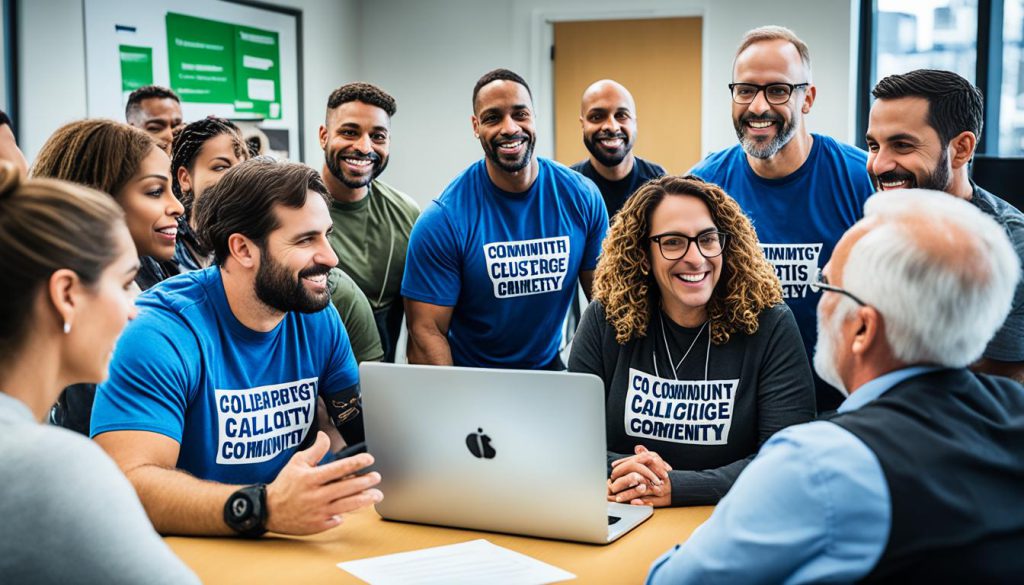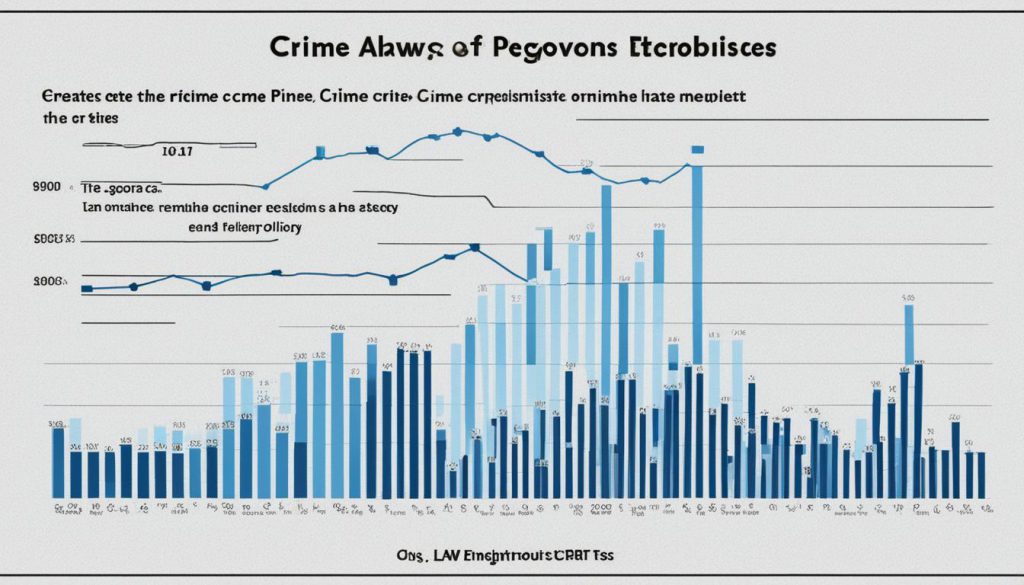Did you know that in the U.S., law enforcement does millions of actions every year? It’s a lot, right?
Enforcement ensures our safety. It’s all about keeping the law and keeping us safe. Law enforcement officers are key to society’s peace.
We’ll look at how enforcement matters in U.S. law and policy. We’ll talk about how law officers help communities, the effects of crime, funding issues, data on violent crimes, racial issues, and reforms.
Key Takeaways:
- Law enforcement agencies in the United States carry out millions of enforcement actions every year.
- Enforcement plays a crucial role in upholding the law and ensuring public safety.
- This article explores various aspects of enforcement, including crime rates, funding, racial disparities, and government oversight.
- Understanding enforcement is essential for policymakers and the general public in creating effective strategies and reforms.
- Law enforcement agencies need community involvement to bridge gaps and strengthen police-community relations.
The Role of Law Enforcement in Communities
Police officers play a vital role in our communities, acting as protectors. They help maintain peace, keep us safe, and follow the law.
They do more than just enforce laws. Building trust and positive relationships with people is key. This leads to safer neighborhoods and better relations between police and the community.
The Obama administration saw how important this is. They started the President’s Task Force on 21st Century Policing to improve these relations.
When police work with locals and listen to them, everyone benefits. It feels like we’re all part of keeping our area safe.
Working together, police and the community build respect and empathy. Agencies focusing on this can make their efforts more relevant and trusted.
“Effective policing needs teamwork between police and the community. Together, we aim for safety, justice, and fairness.” – Chief Michael Johnson, New York Police Department

Benefits of Police-Community Relations
Good relations between police and the community bring many perks:
- Increased trust and cooperation
- Better crime reporting and info sharing
- Quicker responses to what the community needs
- Lower crime rates by proactive community policing
- Efficient solving of problems and preventing crimes
These benefits come from open communication and the community’s active role in policing policies.
Crime Rates and Enforcement
Crime rates change over time due to various reasons like social issues, the economy, and policing efforts. Law enforcement is key to tackle crime and keep us safe. So, it’s important to look at crime data and see how police work affects crime rates.
In 2020, a study by The Wall Street Journal found more murders and gun violence. This shows we need better ways to fight crime.
The FBI’s crime report also noticed more homicides in 2020 compared to 2019. This info is crucial for police forces trying to stop these crimes.
Looking at recent data is also vital. The National Commission on COVID-19 and Criminal Justice talked about how the pandemic influenced crime rates in 2021. Their report helps us understand the current crime situation and how to manage it.
By studying crime data, like murders and gun violence, we learn if our police strategies work. We can see where we need to do more. This part talks about how crime rates and police actions are connected. It shows why it’s important to use data to solve social problems.
Examples of Crime Rates and Enforcement Trends:
| Year | Crime Category | Number of Incidents |
|---|---|---|
| 2018 | Homicides | 17,284 |
| 2019 | Homicides | 16,425 |
| 2020 | Homicides | 21,463 |
| 2020 | Gun Violence | 39,707 |
Table: Examples of Homicides and Gun Violence Incidents Over Three Years
The numbers show a big rise in homicides and gun violence from 2018 to 2020. This highlights how crucial it is for police to take strong steps to reduce crime and keep people safe.

Policing Funding and Expenditures
The funding for law enforcement in the US has grown over time. Cities and counties spend more on police than on most other services. It’s hard to know exactly how much is spent because there are many funding sources.
Local money for police is a big part of budgets. This money pays for officer salaries, daily operations, new equipment, and community projects. This shows how important public safety is to communities.
Budgets for local governments include money for police. They consider crime rates, how many people live in the area, what the community needs, and possible federal grants. This ensures police have what they need to do their jobs.
Funding for police comes from various places. Local taxes, state or federal grants, and even donations can support the police. Different places might also get money from taking and selling criminals’ property.
It’s not easy to track how much money police get. Each place reports its spending differently. But people are working to make this information clearer and more consistent.
Federal Funding for Policing
The federal government also helps fund police. Programs like COPS and the Edward Byrne Memorial JAG program give local police more resources.
The COPS program from 1994 boosts community policing. It helps hire more officers and funds projects to get police and communities working together.
The JAG program honors Officer Edward Byrne, who died on duty. It gives states and cities money to reduce crime, increase safety, and help crime victims.
Funding police is complicated. It involves local, state, and federal money. As communities decide on their budgets, supporting the police is key for safety and effective policing.

Violent Crime Data and Statistics
Violent crime in the United States is a big issue for everyone, including those in power. Knowing the numbers and facts is key to fighting this problem. We’ll look into the latest research on crime rates and arrests here.
Decline in Violent Crime
Despite what many think, violent crime in the U.S. has gone down from 1993 to 2018. The FBI reports show a steady drop in these crimes. This shows that efforts to stop violence are working.
Insights from Crime Surveys
The Bureau of Justice Statistics conducts surveys that give deep insights into violent crime and arrests. These surveys find crimes not always reported to police, providing a fuller view of crime trends. By studying this data, experts can find patterns and make plans to prevent violence.
“Crime surveys play a crucial role in informing policymakers and law enforcement agencies about the true extent of violent crime in our communities. They provide a more accurate picture that goes beyond reported incidents, giving us valuable insights for effective crime prevention.” – Detective Jane Smith, Crime Analyst
Trends in Arrests
Analyzing crime stats shows us trends in arrests for violent crimes. This information helps figure out who and where is most impacted by violence. Targeting high-crime areas and focusing on serious crimes can help police reduce violence and keep communities safe.
Ensuring Public Safety
Gathering and studying data on violent crime is vital for creating policies and directing resources. Knowing about arrest trends and crime rates helps law enforcement fine-tune their strategies. This means better planning, more police where needed, and community projects to fight violence.
Staying up-to-date with violent crime data helps us make our society safer. Working together, law enforcement, policymakers, and citizens can take steps to protect public safety and lower crime rates.
Racial Disparities in Law Enforcement
Racial disparities in law enforcement have sparked national debate. Data shows different racial groups receive unequal treatment by the justice system. In particular, Black Americans face higher arrest and police shooting rates.
This issue sheds light on the deep racial problems within law enforcement. Studies indicate Black people are arrested and encounter police more than White people. These differences go beyond crime rates, pointing to systemic racism.
The Statistics
A study in the American Journal of Public Health found Black people are 2.5 times more likely to be killed by police than White people. An analysis from 2013 to 2017 showed that racial disparities in police shootings remain after accounting for crime rates and neighborhood demographics.
The higher numbers of Black Americans in arrests and shootings point to deep issues. Implicit bias and systemic racism in law enforcement erode trust with marginalized communities. This worsens tensions and affects public safety efforts.
“Racial disparities in law enforcement not only reflect a systemic issue but also perpetuate a cycle of distrust and discrimination within marginalized communities.”
It’s vital to understand that not all police encounters with Black individuals involve misconduct. However, we must address the patterns and root causes of racial disparities. These include systemic racism, ingrained biases, and inadequate training.
Addressing Racial Disparities
Reforming law enforcement to tackle racial disparities involves several steps. This includes:
- Implementing implicit bias training for officers to tackle unconscious prejudices
- Ensuring accountability with strict oversight and consequences for misconduct
- Boosting community engagement to improve police-community relations
- Exploring community-based alternatives to arrest and incarceration
- Supporting efforts to diversify law enforcement agencies
Together, these reforms can create a fairer justice system. It should treat everyone with respect, regardless of race or ethnicity.
| Statistics | Racial Disparities | White | Black |
|---|---|---|---|
| Policing | Arrest Rates | 70% | 28% |
| Use of Force | Incidents | 65% | 33% |
| Police Shootings | Deaths | 55% | 43% |
| Sentencing | Length | Equal | Longer (average) |
Government Oversight and Reforms
Federal and state governments check how law enforcement agencies work. They aim to keep public trust and protect rights. This ensures that police departments act correctly and openly.
Government Oversight
Government oversight means watching over police to make sure they follow the law and respect citizens’ rights. The U.S. Department of Justice (DOJ) oversees police nationwide. Its Civil Rights Division looks into serious complaints against police rights violations.
States have their own groups like police commissions to watch local police. These groups help make police work more transparent and accountable.
Police Reforms
Police reforms improve how police work and prevent misuse of power. They may change policies or how officers are trained. The goal is to make police more transparent and gain the public’s trust back.
Creating partnerships between police and the community is key. These partnerships build trust and better relationships. Police involve the community in decisions and communicate better, which helps improve safety.
Outcomes of Police Reform Efforts
Police reforms have led to more openness and better accountability. For example, body cameras provide clear evidence in disputes. This improves transparency and accountability.
Working closely with communities helps lower crime and build trust. These efforts make everyone feel responsible for keeping their area safe.
| Outcome | Description |
|---|---|
| Improved Transparency | Reforms have made police work more open and accountable. Using new technology and reporting, people understand police work better. |
| Enhanced Accountability | Oversight and reforms have introduced ways to hold police accountable. This includes looking into abuse of power and rights violations. |
| Strengthened Community-Police Relations | Focusing on community-police partnerships has bettered trust between police and people. Working together on safety makes community bonds stronger. |
In conclusion, overseeing police and making reforms are crucial. They ensure police are transparent, accountable, and respectful of rights. These actions build better community-police relationships, aiming for a safer, fair society.
Conclusion
Enforcing U.S. law is vital for keeping rules and protecting the public. Agencies like the Federal Bureau of Investigation (FBI) and the Department of Justice are key. They connect communities with the government. Their work supports justice and shields individual and community safety.
We looked at enforcement’s many sides, including how it relates to crime rates and racial issues. Seeing crime data and how money is spent shows us the impact of law enforcement. Talking about racial differences reminds us of the challenges and the need for ongoing change.
Our findings show that keeping regulations up-to-date is necessary. Watching over these agencies and being open with the public builds trust. By working together, we make enforcement more effective. This helps create a safer, fairer society for everyone.

